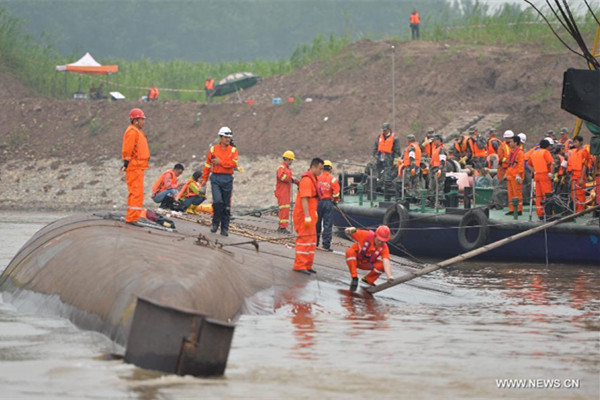How the rescue plan works and why
By Liu Jing (chinadaily.com.cn) Updated: 2015-06-04 16:02
 |
|
Rescuers are seen on the cruise ship Eastern Star that capsized late on Monday in the Jianli section of the Yangtze River in central China's Hubei Province, June 3, 2015. Rescuers have only found 14 survivors, and so far have retrieved 26 bodies, leaving over 400 people still unaccounted for. [Photo/Xinhua] |
Rescuers have cut open three holes into the hull of the capsized ship on Yangtze River since Wednesday night.
The holes are cut at spots where survivors are most likely to be found, said He Jianzhong, vice-minister of transport. They will be sealed to avoid further sinking if no survivors are found there.
At the same time, more than 200 divers continued their underwater search throughout the night.
"The ship sank in a very short time-frame, so there could still be air trapped in the hull," said Li Qixiu, an expert with the Naval University of Engineering, "and that means there could still be survivors."
The bottom of the Eastern Star is cut open while the hull is lifted using steel cables, according to Li.
The real trick is how the vessel will be held steady to prevent it from sinking further during the operation. The escape of any air trapped in the hull could cause the ship to lose what buoyancy it has and sink deeper into the water, he said.
Li said divers have managed to attach steel cables to the hull and they planned to support the ship with cranes while rescuers searched inside.
Authorities had previously weighed a different approach where they planned to lift the capsized ship from the water with steel cables, drain the water from cabins and eventually flip the ship over.
But some navigation experts warned that the second plan of lifting the ship could deprive any potential survivors their last chance to be rescued because the air in the ship's cabins may leak plus turning the vessel could hurt those inside it.
- Govt encourages people to work 4.5 days a week
- Action to be taken as HIV cases among students rise
- Debate grows over reproductive rights
- Country's first bishop ordained in 3 years
- China builds Tibetan Buddhism academy in Chengdu
- Authorities require reporting of HIV infections at schools
- Typhoon Soudelor kills 14 in East China
- Police crack down on overseas gambling site
- Debate over death penalty for child traffickers goes on
- Beijing to tighten mail security for war anniversary







